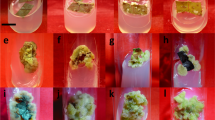Abstract
In vitro propagation protocol was developed for Saussurea lappa (Clarke.) species threatened by over exploitation due to medicinal importance and habitat destruction in Ladakh region of India. The aim of the present study was to examine the main aspects of in vitro callus induction (CI) and plantlet regeneration of S. lappa. Explants were cultured on Murashige and Skoog (MS) basal medium supplemented with various concentrations and combinations of auxins and cytokinins for in vitro CI and plantlets regeneration. Callus initiation and induction was observed within eight and fifteen days after inoculation. 3 mg/L 2, 4-Dichlorophenoxyacetic acid (2, 4-D) and 5 mg/L Kinetin (Kin) was found to be more effective for CI frequencies in all the explants as compared to other combinations. Root (79.6 ± 0.8) and stem (76.4 ± 0.6) explants were found with better callus frequencies and early response as compared to other explants. Maximum number of shoots (11.8 ± 0.7), highest shoot length (9.2 ± 0.6 cm), maximum root number (6.2 ± 0.7) and highest root length (6.6 ± 0.8 cm) were found on MS medium with 2 mg/L Kinetin (Kin) and 2 mg/L Indole-3-butyric-acid in root derived callus explant. Plantlets with 3–5 shoots were transferred to potting mixture containing sand: soil: perlite (1:1:1) for acclimatization to field conditions and further multiplication. For the first time, protocol has been developed in S. lappa for in vitro CI and plantlet regeneration that holds robust potential for metabolite production and large-scale propagation.






Similar content being viewed by others
References
Warghat AR, Bajpai PK, Murkute AA, Sood H, Chaurasia OP, Srivastava RB (2012) Genetic diversity and population structure of Dactylorhiza hatagirea (Orchidaceae) in cold desert Ladakh region of India. J Med Plant Res 6(12):2388–2395
BGCI (Botanic Gardens Conservation International) (2002) International agenda for botanic gardens in conservation. Botanic Gardens Conservation International, Kew
Guerrant EO, Fiedler PL, Havens K, Maunder M (2004) Revised genetic sampling guidelines for conservation collections of rare and endangered plants. In: Guerrant EO, Havens K, Maunder M (eds) Ex situ plant conservation supporting species survival in the wild. Island Press, Washington, pp 419–442
Polunin O, Stainton A (1984) Flowers of the Himalayas. Oxford University Press, New Delhi, p 4
Kala CP (2003) Medicinal plants of the Indian Trans Himalaya: focus on Tibetan use of medicinal resources. Bishan Singh Mahendra Pal Singh, Dehradun, p 200
Gokhale AB, Damre AS, Kulkami KR, Saraf MN (2002) Preliminary evaluation of anti-inflammatory and anti-arthritic activity of S. lappa, A. Speciosa and A. Aspera. Phytomedicine 9(5):433–437
Kuniyal CP, Rawat YS, Oinam SS, Kuniyal JC, Vishvakarma SCR (2005) Kuth (Saussurea lappa) cultivation in the cold desert environment of the Lahaul valley, northwestern Himalaya, India: arising threats and need to revive socio-economic. Biodivers Conserv 14(5):1035–1045
Kirtikar KR, Basu BD (1987) Indian medicinal plants. International Book Distributors, Dehradun, pp 2061–2062
Chaurasia OP, Ahmed Z, Ballabh B (2007) Ethnobotany and plants of Trans-Himalaya. Satish Serial Publishing House, Delhi
Arora R, Bhojwani SS (1989) In vitro propagation and low temperature storage of Saussurea lappa C.B. Clarke—an endangered medicinal plant. Plant Cell Rep 8:44–47
Verma P, Mathur AJ, Jain SP, Mathur A (2012) In vitro conservation of twenty-three overexploited medicinal plants belonging to the Indian sub continent. Sci world J 2012:1–10
Murashige T, Skoog F (1962) A revised medium for rapid growth and bioassays with tobacco tissue cultures. Physiol Plant 15(3):473–497
SPSS (1999) Statistical Packages for Social Sciences, Version 21.0 SPSS Inc., Chicago, IL, USA
Guo M, Gao M, Liu CZ (2007) In vitro propagation of an endangered medicinal plant Saussurea involucrata Kar. et Kir. Plant Cell Rep 26:261–265
Zilis M, Zwagerman D, Lamberts D, Kurtz L (1979) Commercial propagation of herbaceous perennials by tissue culture.In: Proceedings International Plant Propagator’s Society 9: 404–414
Parrot WA, Bailey MA, Durham RE, Mathews HV (1992) Tissue cultures and regeneration in legumes. In: Moss JP (ed) Biotechnology and crop improvement in Asia. ICRISAT, Patancheru, pp 115–148
Mneny EE, Mantell SH (2002) Clonal propagation of cashew (Anacardium occidentale L.) by tissue culture. J Hort Sci 77:649–657
Kevers C, Coumans M, Coumans G, Caspar T (1984) Physiological, biochemicals events leading to vitrification of plants cultured in vitro. Plant Physiol 61:69–74
Warghat AR, Bajpai PK, Srivastava RB, Chaurasia OP, Chauhan RS, Sood H (2014) In vitro protocorm development and mass multiplication of an endangered orchid, Dactylorhiza hatagirea. Turk J Bot 38:737–746
Johnson TS, Narayan SB, Narayana DBA (1997) Rapid in vitro propagation of Saussurea lappa, an endangered medicinal plant, through multiple shoot cultures. In Vitro Cell Dev Biol Plant 33:128–130
Gailite A, Klavina D, Levinsh G (2010) In vitro propagation of an endangered plant Saussurea esthonica. Environ Exp Biol 8:43–48
Acknowledgments
Authors are thankful to Defence Research and Development Organization (DRDO), Ministry of Defence, Government of India for providing financial assistance for the research.
Conflict of interest
The authors declare that they have no conflict of interest.
Author information
Authors and Affiliations
Corresponding author
Rights and permissions
About this article
Cite this article
Warghat, A.R., Bajpai, P.K., Rewang, S. et al. In Vitro Callus Induction and Plantlet Regeneration of Saussurea lappa (Clarke.) from Ladakh Region of India. Proc. Natl. Acad. Sci., India, Sect. B Biol. Sci. 86, 651–660 (2016). https://doi.org/10.1007/s40011-015-0496-y
Received:
Revised:
Accepted:
Published:
Issue Date:
DOI: https://doi.org/10.1007/s40011-015-0496-y




